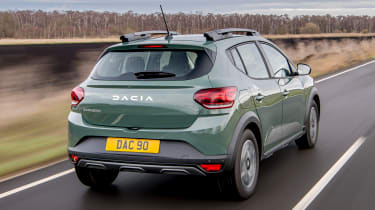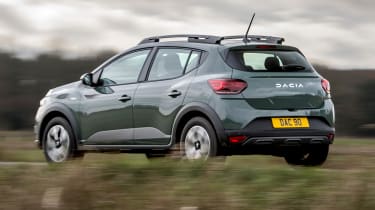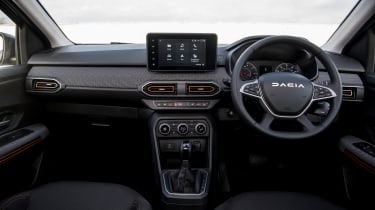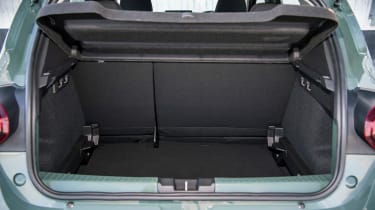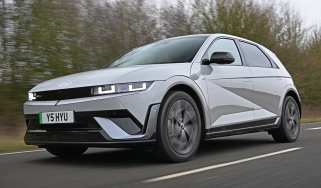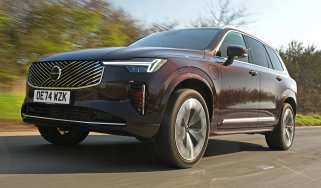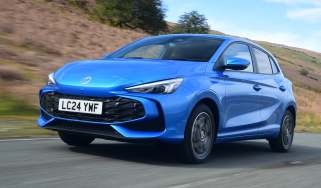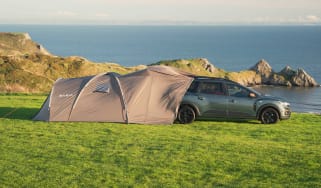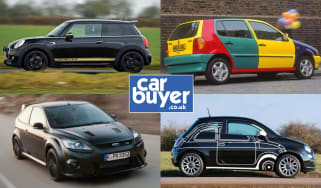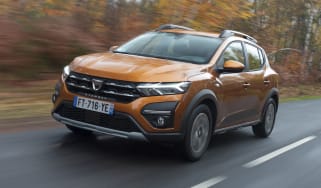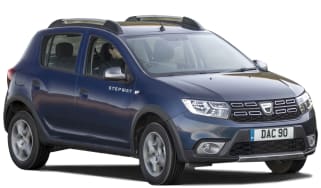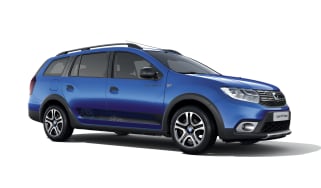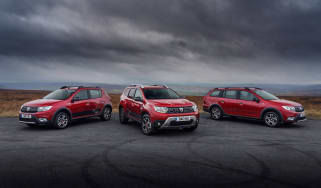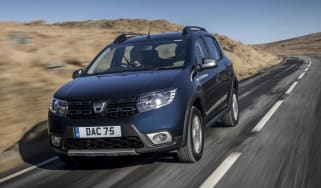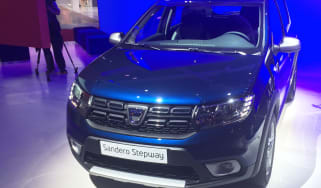Dacia Sandero Stepway review – a tough bargain supermini
"Headline-grabbing price and improved features make the Dacia Sandero Stepway a tempting option"
Pros
- Great value
- Smart interior
- LPG version available
Cons
- Mediocre performance
- Just one engine
- Wind noise on motorway
Verdict – Is the Dacia Sandero Stepway a good car?
Considering just how much you get for your money, the Sandero Stepway represents staggering value. The fact there are now fewer compromises in key areas like interior tech and safety equipment only adds to its desirability, and should help broaden Dacia's appeal. The higher ride and slightly more rugged trim on the Stepway compared to the standard Sandero will appeal if you live in a more rural setting.
Dacia Sandero Stepway models, specs and alternatives
Since its arrival, the Dacia Sandero has filled an important niche as one of Britain's most affordable supermini. The latest high-riding Sandero Stepway builds on this, offering vastly improved safety and technology, along with an added dose of style and practicality.
The price really is the main selling point when it comes to the Sandero Stepway. This five-seat hatchback with trendy SUV styling starts from just over £15,000 and even the range-topping Extreme model is well under £20,000.
 Top 10 best cheap-to-run cars 2025
Top 10 best cheap-to-run cars 2025
In the old model, it was easy to spot some of the cost-cutting measures at a glance but they're better hidden this time. It's a neater design than before, with attractive Y-shaped daytime running lights, swollen wheel arches, chunky alloy wheels and skid-plate style trim beneath the bumpers. The modular roof bars are a neat design too, turning into a roof rack for heavy or bulky items that won't fit in the 328-litre boot.
More reviews
The Sandero is based on the same underpinnings as the latest Renault Clio – a past winner of our Best Small Car award – and that's most evident inside. The climate control knobs are identical for instance, and overall, materials in the Stepway have taken a big step up in quality. We'd recommend skipping the Essential trim and going straight for Expression; its eight-inch touchscreen makes the interior feel modern, while Apple CarPlay and Android Auto should also keep connectivity up-to-date.
March 2023 saw the introduction of the top-of-the-range Extreme trim level. It added some genuine off-roading capability to the Stepway, with the inclusion of Dacia’s ‘Extended Grip’ feature. This is activated via a button on the centre console and adjusts the car’s electronic stability control to maintain traction over loose surfaces. Extreme models also get unique styling with copper brown exterior trim pieces, an exclusive Cedar Green body colour and black alloy wheels.
All three engine options are versions of the same petrol three-cylinder, badged either TCe 90, TCe 110 or TCe 100 Bi-Fuel. The TCe 90 is the cheapest option and will suit most drivers, returning around 50mpg. The Bi-Fuel is intriguing, because it's one of the only cars on sale in the UK with an LPG (liquid petroleum gas) fuel tank in addition to its petrol one. This means it can switch between the two fuels, with LPG costing significantly less to buy.
The TCe 110 is new for 2024, bumping the three-cylinder’s power output to 108bhp at the expense of fuel economy, which drops to 45.6mpg. It’s the most expensive option of the lot, and only available for the top-spec Extreme model.
The CVT automatic version was discontinued in Essential and Expression trim, but is still solely available on the Extreme models of the Sandero Stepway, although we’d stick with the slick manual version anyway.
MPG, running costs & CO2
Considering the price of the Sandero Stepway is so low, even without the most economical engine fitted, your motoring budget would still be in the green. So the fact the 1.0-litre three-cylinder petrol engine is pretty thrifty only makes the Dacia more compelling. There are three versions available – the standard TCe 90, the TCe 100 Bi-Fuel version that can run on petrol or LPG fuel, and the range-topping TCe 110.
The TCe 90 will be adequate for most drivers, returning a very reasonable 50.4mpg, while emitting 127g/km of CO2 for a middling Benefit-in-Kind band. In Extreme trim, this engine can be paired with a CVT automatic gearbox, although fuel economy drops to 45.6mpg and emissions climb to 140g/km.
The TCe 110 model gets an extra 20bhp at the cost of fuel economy – dropping to 45.6mpg as well – a trade-off that won’t be worthwhile for most buyers. It’s also more expensive and limited to the top-spec Extreme model.
What about the TCe 100 Bi-Fuel engine? Probably due to the added weight of the extra tank, petrol fuel economy is marginally worse than the TCe 90 at 48.7mpg. If you live near an LPG pump, however, you get the choice of filling it with the cheaper fuel – on LPG it will return up to 38.2mpg. Dacia is currently the only mainstream UK brand to offer an LPG tank as well as the petrol tank, with a switch to flick between the two fuels.
The advantage is that LPG is around half the price to buy, although there are a few caveats. Aside from the slightly worse fuel economy, there’s also the fact that not every forecourt sells it – it's worth checking where you can buy LPG in your area before relying on it. Happily, emissions while running on LPG are also lower at around 115g/km, compared with 131g/km of CO2 when running on petrol.
Insurance groups span from 10 (out of 50) for the TCe 90 Auto to group 14 for the TCe 100 Bi-Fuel, so the Stepway is unlikely to be expensive to insure for most drivers. Vehicle tax costs the standard VED rate each year.
Engines, drive & performance
Our most recent drive of the Sandero Stepway only served to reaffirm what we already knew about the budget crossover. It’s not a car that’s been built for keen drivers, but that was never the idea anyway. You sit quite upright in the Sandero Stepway, putting it in between a traditional supermini and an SUV in terms of driving position, and visibility is good. The ride is very soft, ironing out bumps and potholes effectively for the most part, although it can be shaky and suffer from lots of vibration around town.
At motorway speeds the Sandero Stepway unfortunately feels much less refined. Corners may have been cut in terms of sound deadening in Dacia’s supermini, because there’s lots of wind- and road noise in comparison to many of its rivals.
Just like in the standard Sandero, the Sandero Stepway’s 1.0-litre three-cylinder turbocharged engine is simple. We much prefer the six-speed manual gearbox to the CVT automatic – it’s surprisingly nice to use, though you will find you have to work it fairly rigorously to get the most out of the Stepway’s performance.
The TCe 100 Stepway isn't exactly quick, taking 11.9 seconds to get from 0-62mph and topping out at 109mph. It's not the sort of car you take out for a drive just for the heck of it, but it's quick enough to easily keep up with traffic.
The TCe 90 has an 89bhp three-cylinder petrol engine and manual gearbox. It’s only slightly behind the TCe 100 engine, managing 0-62mph in 12 seconds and a top speed of 107mph. The 108bhp TCe 110 is the nippiest of the lot, completing the same 0-62mph sprint in 10 seconds flat, and its extra power could be desirable if you live in a rural area with lots of hilly roads, or often drive on the motorway.
Buyers can opt for a CVT automatic gearbox with the TCe 90 engine on the range-topping Extreme model. Officially, the automatic Sandero Stepway is the slowest of the range, taking 14.2 seconds to get from 0-62mph. We recommend sticking to the manual gearbox if you can, however, as the CVT auto can be a little slow to react.
Interior & comfort
The interior could be the area of most noticeable improvement over the old model, because its design now appears more modern and less obviously 'budget', and feels durable enough – despite the car’s small price tag. Top versions feature soft-touch material and stylish trim, there's padding where your elbows rest on the doors, and Expression models even get an eight-inch touchscreen. There are also neat touches like a smartphone holder on the dashboard, complete with a USB charger right next to it so you don't need to trail wires across the fascia.
Trim levels are called Essential, Expression and Extreme, with the latter offering some unique styling elements and touches to make the model slightly more capable off-road. The entry-level car gets 16-inch wheels, air conditioning, DAB radio, Bluetooth and a smartphone holder. We think it's worth choosing Expression to get the eight-inch touchscreen with Apple CarPlay and Android Auto. It also gets soft-touch interior trim, keyless entry, rear parking sensors and a rear-view camera.
As well as Dacia’s ‘Extended Grip’ feature, which adjusts the car’s stability control for driving over loose surfaces at the touch of a button, the range-topping Extreme versions get a unique Cedar Green paint scheme with black alloy wheels, Copper Brown exterior trim elements and unique pattern on the front doors, side guards and interior. It also features automatic air-conditioning and six speakers instead of four.
Practicality & boot space
Rather like Skoda in the Volkswagen Group, Dacia is Renault's affordable and practical sister brand. Not only does it have a raised ground clearance, but the Stepway also gets a boost over the normal Sandero thanks to its modular roof bars, fitted as standard to Comfort and Prestige versions. These can quickly be converted into a roof rack, and they can carry an impressive load of up to 80kg on the roof – all without having to splash out on accessories.
There's plenty of room inside, too, with two adults who sat in the back during our test drive both remarking on how comfortable it was. There's a decent seating position for the driver and visibility is also pretty good, no doubt helped slightly by the higher ride height. Boot space measures 328 litres, but like the Renault Clio, there's a fairly high boot lip to lift heavy items over. Choose the Bi-Fuel version and the LPG tank is hidden under the boot floor, but this does mean there's no longer a spare wheel.
Reliability & safety
While Dacia models have always majored on affordability, this has come at the expense of safety kit in some models. Thankfully, the move to more advanced new underpinnings has given Dacia access to the latest safety features from across the Renault group.
For instance, autonomous emergency braking can now help mitigate or avoid a collision, and it's fitted as standard. If a serious collision should occur, there are six airbags and an E-call system will automatically alert the emergency services of the vehicle's location.
When the new Sandero Stepway was tested by Euro NCAP, it scored a paltry two stars, due to the lack of standard-fit safety systems. However, as of April 2024, all new Sandero Stepways come with more safety tech as standard in order to comply with European GSR2 regulations. This includes upgraded automatic emergency braking with pedestrian and cyclist detection, lane-keeping assistance, lane departure warning and driver attention monitoring.
The Sandero Stepway's petrol engines are very common across other Renault models, and should prove cheap to maintain and robust. It's a shame the three-year or 60,000-mile warranty isn’t longer, though, as many rivals from the likes of Toyota and Hyundai now come with five years of cover or more. It's also a worry that Dacia could only manage 26th out of 32 brands in our most recent Driver Power owner satisfaction survey, well behind the likes of Citroen in 10th spot and Skoda in 20th.
Which Is Best?
Cheapest
- Name1.0 TCe Essential 5dr
- Gearbox typeManual
- RRP£15,795
Most Economical
- Name1.0 TCe Essential 5dr
- Gearbox typeManual
- RRP£15,795
Fastest
- Name1.0 TCe 110 Extreme 5dr
- Gearbox typeManual
- RRP£19,145
